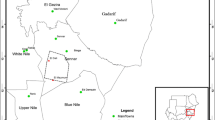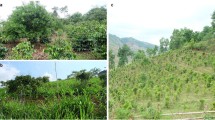Abstract
Smallholder farmers in Tigray have been growing Rhamnus prinoides trees/shrubs with annual crops in rain-fed farmlands. Although this agroforestry system is widely practiced, there are no sufficient scientific reports on its profitability and financial returns. The objective of this research was to analyze the financial profitability and relative financial advantages of R. prinoid-based agroforestry compared to monocropping practices, in eastern Tigray. Data were collected using a structured questionnaire from 123 randomly selected households who practiced R. prinoides-based agroforestry. To address the objective, we estimated the net present values (NPV), Annuity values, and benefit to cost ratio (BCR) on per hectare basis. The annuity and BCR of agroforestry were compared with those of adjacent monoculture farms of the associated crop components in agroforestry. The land equivalent ratios (LER) of the agroforestry were calculated and compared with sole crops. The NPV and BCR of the agroforestry were 5.6 and nearly fourfold higher than that of the monocropping, respectively. Similarly, the R. prinoides-based agroforestry LER was 0.33–1.36% higher as compared to monocultures. Stocking density and age of agroforestry affected the financial return from R. prinoides-based agroforestry. We concluded that R. prinoides-based agroforestry has superior financial performance over monocrops and is financially less risky. Therefore, the adoption of R. prinoides-based agroforestry practices is a viable option for smallholder farmers to maximize net returns from their rain-fed farmlands and resource inputs.





Similar content being viewed by others
References
Adane F, Legesse A, Weldeamanuel T, Belay T (2019) The contribution of a fruit tree-based agroforestry system for household income to smallholder farmers in dale district, sidama zone, southern ethiopia. Adv Plants Agric Res 9:66
Ajayi O, Akinnifesi F, Sileshi G, Kanjipite W (2009) Labour inputs and financial profitability of conventional and agroforestry based soil fertility management practices in Zambia. Agrekon 48(3):276–292
Algamal ZY (2018) Shrinkage estimators for gamma regression model. Electron J Appl Stat Anal 11:253–268
Anshiso A, Woldeamanuel T, Asfaw Z (2017) Financial analysis of fruit tree based agroforestry practice in Hadero Tunto Zuria Woreda, Kembata Tembaro Zone, South Ethiopia. Res J Finance Acc 8(3):66
Bertomeu M (2006) Financial evaluation of smallholder timber based agroforestry systems in Claveria, Northern Mindanao, Philippines. Small-Scale For Econ Manag Polic 5(1):57–82
Birhanu Z (2013) Traditional use of medicinal plants by the ethnic groups of Gondar Zuria District, North-Western Ethiopia. J Nat Remed 13(1):66
Bowman MS, Zilberman D (2013) Economic factors affecting diversified farming systems. Ecol Soc 18:66
Campbell M, Fathi R, Cheng S, Ho A, Gilbert E (2020) Rhamnus prinoides (Gesho) stem extract prevents co-culture biofilm formation by Streptococcus Mutans and Candida Albicans. Lett Appl Microbiol 71:294–302
Carsan S, Stroebel A, Dawson I, Kindt R, Mbow C, Mowo J, Jamnadass R (2014) Can agroforestry option values improve the functioning of drivers of agricultural intensification in Africa? Curr Opin Environ Sustain 6:35–40
Chavan SB, Dhillon RS, Sirohi C, Keerthika A, Kumari S, Bharadwaj KK, Jinger D, Kakade V, Chichaghare AR, Zin El-Abedin TK, Mahmoud EA, Casini R, Sharma H, Elansary HO, Yessoufou K (2022) Enhancing farm income through boundary plantation of poplar (Populus Deltoides): an economic analysis. Sustainability 6:66
CSA (Cetral statistical authority) (2018) Central Statistical Authority of the Federal Democratic Republic of Ethiopia, National Planning Commission. Annual Report
Current D, Lutz E, Scherr SJ (1995) The costs and benefits of agroforestry to farmers. Oxford University Press 10(2):151–180
Duguma LA (2013) Financial analysis of agroforestry land uses and its implications for smallholder farmers livelihood improvement in Ethiopia. Agrofor Syst 87:217–231
FAO (1992) Economic assessment of forestry projects. FAO forestry paper No. 163, Rome
Franzel S, Coe R, Cooper P, Place F, Scherr SJ (2001) Assessing the adoption potential of agroforestry practices in sub-Saharan Africa. Agric Syst 69:37–62
Friday J, Cabal C, Yanagida J (2000) Financial analysis for tree farming in Hawaii
Garnett T, Appleby MC, Balmford A, Bateman IJ, Benton TG, Bloomer P, Burlingame B, Dawkins M, Dolan L, Fraser D (2013) Sustainable intensification in agriculture: premises and policies. Science 341:33–34
Gebremeskel D, Abebe B, Gidey K, Berihu T (2018) Effect of Rhamnus prinoide (Gesho) intercropping in wheat field on soil nutrient and moisture in the drylands of North Ethiopia. Momona Ethiop J Sci 10(1):126–139
Gebremeskel D, Birhane E, Rannestad MM, Gebre S, Tesfay G (2021) Biomass and soil carbon stocks of Rhamnus prinoides based agroforestry practice with varied density in the Drylands of Northern Ethiopia. Agrofor Syst 95:1275–1293
Gockowski J, Van Asten PJ (2012) Agricultural intensification as a climate change and food security strategy for sub-Saharan Africa
Idol T, Haggar J, Cox L (2011) Ecosystem services from smallholder forestry and agroforestry in the tropics. In: Campbell W, Lopez Ortiz S (eds) Integrating agriculture, conservation and ecotourism: examples from the field. Issues in agroecology—present status and future prospectus, vol 1. Springer, Dordrecht. https://doi.org/10.1007/978-94-007-1309-3_5
Janaki RR, Alavalapati D, Mercer E, Montambault JR (2004) Agroforestry systems and valuation methodologies. Kluwer, The Netherlands, pp 1–8
Kasa G (2015) Profitabiltiy analsysis and determinants of fruit based af systems in Wondo Genent District, Ethiopia. Afr J Agric Res 10(11):1273–1280
Khosravi S, Namiranian M, Ghazanfari H, Shirvani A (2012) Crown biomass relationships of Lebanon Oak in northern Zagros forests of Iran. Croat J For Eng 33:239–247
Klemperer WD (2003) Forest resource economics and finance. Mcgraw-Hill, New York
Kotir JH (2011) Climate change and variability in sub-Saharan Africa: a review of current and future trends and impacts on agriculture and food security. Environ Dev Sustain 13:587–605. https://doi.org/10.1007/s10668-010-9278-0
Kurtz WB, Garrett HE, Slusher JP (1996) Economics of agroforestry, School of Natural Resources D.B. Osburn, Department Of Agricultural Economics. MU Guide Published By University Extension, University Of Missouri-Columbia
Martinelli GdC, Schlindwein MM, Padovan MP, Gimenes RMT (2019) Decreasing uncertainties and reversing paradigms on the economic performance of agroforestry systems in Brazil. Land Use Policy. https://doi.org/10.1016/j.landusepol.2018.09.019
Melvani K, Myers B, Palaniandavan N, Kaestli M, Bristow M, Crase B, Moles J, Williams R, Abeygunawardena P (2020) Forest gardens increase the financial viability of farming enterprises in Sri Lanka. Agrofor Syst. https://doi.org/10.1007/s10457-020-00564-9(01
Möhring B, Rüping U (2008) A concept for the calculation of financial losses when changing the forest management strategy. For Policy Econ 10:98–107
Mueller ND, Gerber JS, Johnston M, Ray DK, Ramankutty N, Foley JA (2012) Closing Yield gaps through nutrient and water management. Nature 490:254–257
Muhammad E, Syed M, Sarwat N, Irshad A, Mohammad A (2011) Contribution of argoforestry in farmers’ livelihoods and its impact on natural forest in northern area of Pakistan. Af. Biothechnol 10:15529–15539
National Bank of Ethiopia (NBE) (2018) The annual report of national bank of Ethiopia
Negash AW, Tadesse BT, Tsehai BA (2021) Assessment and determination of bittering agents, essential oils, and antioxidants of Gesho (Rhamnus prinoides L. Herit) collected from Amhara Region, Ethiopia. Hindawi J Chem 2021:1–7
Norgrove L, Beck J (2016) biodiversity function and resilience in tropical agroforestry systems including shifting cultivation. Curr For Rep 2:62–80
Orwa C, Mutua A, Kindt R, Jamnadass R, Anthony S (2009) Agroforestree database: a tree reference and selection guide version 4.0. World Agroforestry Centre, Kenya
Padovan MP, Nogueira FF, Ruas FG, Rodrigues ACC, Arco-Verde MF (2022) Financial analysis of a complex agroforestry system for environmental restoration purpose in the Brazilian Rainforest. Agrofor Syst 96(2):235–248. https://doi.org/10.1007/s10457-021-00655-1
Paul C, Weber M, Knoke T (2017) Agroforestry versus farm mosaic systems–comparing land-use efficiency, economic returns and risks under climate change effects. Sci Total Environ 587:22–35
Rahman S, Fahrana K, Rahman A, Imtia A (2007) An economic evaluation of multi-strata argoforestry systems in the northern bangladesh. Am Eurasian J Agri Environ Sci 2:655–661
Rasul G, Thapa GB (2006) Financial and economic suitability of agroforestry as an alternative to shifting cultivation: the case of the Chittagong Hill tracts, Bangladesh. Agric Syst 91:29–50
S’anchez AC, Kamau HN, Grazioli F, Jones SK (2022) Financial profitability of diversified farming systems: a global meta-analysis. Ecol Econ. https://doi.org/10.1016/j.ecolecon.2022.107595
Seserman DM (2018) Benefits of agroforestry systems for land equivalent ratio-case studies in brandenburg and lower saxony, Germany. In: Proceedings of the 4th European agroforestry conference-agroforestry as sustainable land use, Nijmegen, The Netherlands, pp 28–30
Shode Y, Woldeamanuel T (2016) Financial analysis of moringa tree based agroforestry practice against mono-cropping system in Konso District (Woreda), Southern Ethiopia. J Econ Sustain Dev 7(21):66
Singh G, Mutha S, Bala N (2007) Effect of tree density on productivity of a Prosopis Cineraria agroforestry system in North Western India. J Arid Environ 70:152–163
Sullivan GM, Susan MH, Jefferson MF (1992) Financial and economic analyses of agroforestry systems. Paia, IL: Nitrogen Fixing Tree Association. In: Proceedings of a workshop held in Honolulu. Hawaii, USA
Sun J, Wang M, Lyu M, Niklas KJ, Zhong Q, Li M, Cheng D (2019) Stem diameter (and not length) limits twig leaf biomass. Front Plant Sci 10:185
Thompson D, George B (2008) Financial and economic evaluation of agro forestry. Agroforestry For Natural Resource Management. Agrofor Nat Resour Manag 66:281–303
Tilahun M, Roland Olschewski R, Kleinn C, Gebrehiwot K (2007) Economic analysis of closing degraded boswellia papyrifera dry forest from human interventions. A study from Tigray, Northern Ethiopia. For Policy Econ 66:996–1005
Waldén P, Ollikainen M, Kahiluoto H (2020) Carbon revenue in the profitability of agroforestry relative to monocultures. Agroforest Syst 94:15–28. https://doi.org/10.1007/s10457-019-00355-x
Worku M, Bantihun A (2017) Review on Woody Species and SocioEconomic Roles of Traditional Agroforestry Practices in Ethiopia. J Fundam Renew Energy 7:246. https://doi.org/10.4172/2090-4541.1000246
Acknowledgements
The research was financially supported by Mekelle University and Norwegian Aid (NORAD) project—Sustainable Forest Management section. We also gratefully acknowledge the farmers who gave generously of their time and knowledge to this study. We acknowledge the Institute of International Education-Scholars Rescue Fund (IIE-SRF), Norwegian University of Life Sciences (NMBU), Faculty of Environmental Sciences and Natural Resource Management (MINA), and NORGLOBAL 2 project “Towards a climate-smart policy and management framework for conservation and use of dry forest ecosystem services and resources in Ethiopia [Grant Number: 303600]” for supporting the research stay of Emiru Birhane at NMBU.
Funding
Mekelle University and Norwegian University of Life Science Institutional Collaboration Project (phase IV) (CRPO/CDANR/PhD/MU-NMBU/013/2010).
Author information
Authors and Affiliations
Contributions
A.T., D.G. and E.B. wrote the main manuscript text, E.B., A. M.M. and M.M.R reviewed the manuscript, and A.T. prepared figures 1-5. All authors reviewed the manuscript."
Corresponding author
Ethics declarations
Conflict of interest
The authors declared that they have no competing of interest.
Additional information
Publisher's Note
Springer Nature remains neutral with regard to jurisdictional claims in published maps and institutional affiliations.
Supplementary Information
Below is the link to the electronic supplementary material.
Rights and permissions
Springer Nature or its licensor (e.g. a society or other partner) holds exclusive rights to this article under a publishing agreement with the author(s) or other rightsholder(s); author self-archiving of the accepted manuscript version of this article is solely governed by the terms of such publishing agreement and applicable law.
About this article
Cite this article
Tesfay, A., Birhane, E., Gebremeskel, D. et al. Financial returns of Rhamnus prinoides based agroforestry practice in Tigray, Ethiopia. Agroforest Syst 98, 679–696 (2024). https://doi.org/10.1007/s10457-023-00939-8
Received:
Accepted:
Published:
Issue Date:
DOI: https://doi.org/10.1007/s10457-023-00939-8




